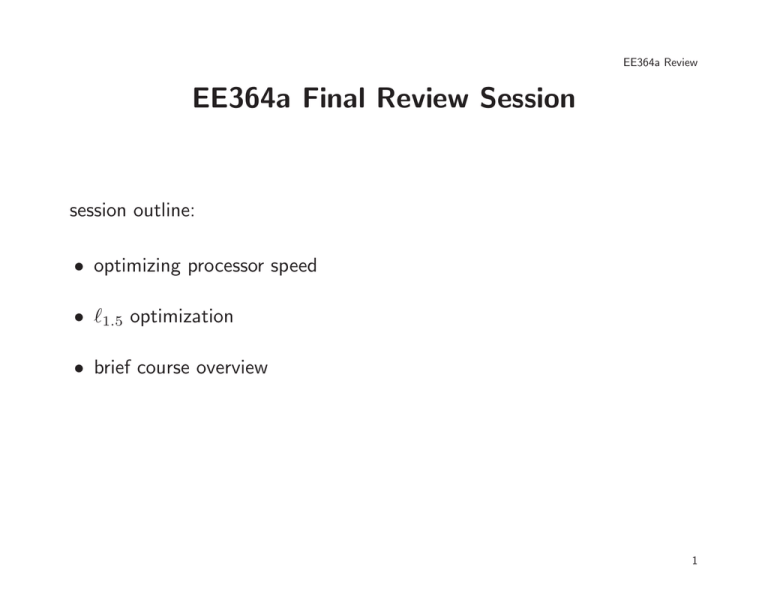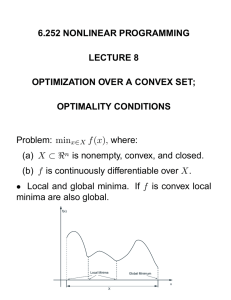EE364a Final Review Session
advertisement

EE364a Review
EE364a Final Review Session
session outline:
• optimizing processor speed
• ℓ1.5 optimization
• brief course overview
1
Optimizing processor speed
•
•
•
•
set of n tasks to be computed by n processors
processor power f (si), where smin ≤ si ≤ smax is speed
task i completed in time τi = αi/si
total processor energy
X
E=
(αi/si)f (si)
i
• precedence constraint set P ⊆ {1, . . . , n} × {1, . . . , n}, described by
graph (DAG), e.g.,
5
EE364a Final Review Session
1
4
2
3
6
2
problem:
1. formulate the problem of minimizing completion time T subject to
E ≤ Emax as a convex optimization problem
2. generate the optimal tradeoff curve of E versus T for
f (s) = 1 + s + s2 + s3
issues:
• how do we deal with E ≤ Emax?
• how do we deal with precedence constraints?
EE364a Final Review Session
3
Energy constraint
• energy function
E=
X
(αi/si)f (si)
i
not convex in s in general
• write E in terms of τi = αi/si
E=
n
X
τif (αi/τi)
i=1
• convex (perspective)
• speed constraints become time constraints
αi/smax ≤ τi ≤ αi/smin,
EE364a Final Review Session
i = 1, . . . , n
4
Completion time
• introduce variable t
• ti is an upper bound on completion time of task i
• T ≤ maxi ti, by construction
• precedence constraints can be expressed as
tj ≥ t i + τ j ,
(i, j) ∈ P.
and
ti ≥ τ i ,
EE364a Final Review Session
i = 1, . . . , n
5
Convex formulation
minimize max
Pn i ti
subject to
i=1 τi f (αi /τi ) ≤ Emax
αi/smax ≤ τi ≤ αi/smin,
ti ≥ τi, i = 1, . . . , n
tj ≥ ti + τj , (i, j) ∈ P
i = 1, . . . , n
• variables are t and τ
• energy constraint is convex
• precedence constraints are affine
• problem is convex
EE364a Final Review Session
6
Optimal tradeoff curve
4000
3500
3000
Energy
2500
2000
1500
1000
500
0
0
2
4
6
8
10
12
14
16
18
20
Time
EE364a Final Review Session
7
ℓ1.5 optimization
minimize kAx − bk1.5 =
Pm
T
i=1 |ai x
3/2 2/3
− bi |
problem:
1. give simple optimality conditions for this problem
2. formulate this problem as an SDP
EE364a Final Review Session
8
Optimality conditions
equivalent problem
minimize f (x) =
Pm
3/2
T
x
−
b
|
|a
i
i=1 i
• objective differentiable
• use first order optimality conditions
∇f (x) =
EE364a Final Review Session
m
X
i=1
(3/2) sgn(aTi x − bi)|aTi x − bi|1/2ai = 0
9
SDP formulation
equivalent problem
minimize 1T t
subject to s3/2 t,
−si aTi x − bi si
i = 1, . . . , m
• variables x ∈ Rn, s, t ∈ Rm
• problem convex, but not an SDP
• need to transform s3/2 t into an LMI
EE364a Final Review Session
10
LMI transformation
using
u v
v w
0 ⇔ u ≥ 0, uw ≥ v 2
we have that the constraint
3/2
si
≤ ti
is equivalent to
√
si si
si
t
0
which in turn is equivalent to the LMI
EE364a Final Review Session
yi si
si ti
0,
si yi
yi 1
0
11
SDP formulation
putting it all together
minimize 1T t
subject to −si aTi x
...,m
− bi si, i = 1,
si yi
yi si
0, i = 1, . . . , m
0,
yi 1
si ti
• SDP with variables x, s, t, and y
• same technique can be used for other problems involving polynomials
• see literature on sum of squares (SOS) methods
EE364a Final Review Session
12
Brief course overview
what have you learned?
• theory
• applications
• algorithms
EE364a Final Review Session
13
Theory
• convex sets and functions
• operations that preserve convexity
• convex optimization problems
• duality
EE364a Final Review Session
14
Applications
• approximation and fitting
– least-norm problems
– robust approximation
– function fitting
• statistical estimation
– parametric estimation
– optimal detector design
– experiment design
• geometric problems
– classification
– placement problems
– floor planning
many others...
EE364a Final Review Session
15
Algorithms
• exploiting structure
• unconstrained minimization
– gradient descent
– steepest descent
– Newton’s method
• equality constrained Newton’s method
• interior-point methods
EE364a Final Review Session
16
Final comment
good luck on your exam!
EE364a Final Review Session
17

